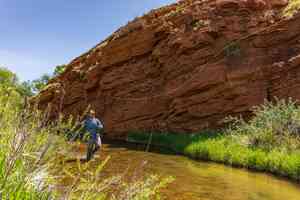As an angler it's easy to get down on the coal industry. What they've done to water and air quality over the centuries is a crime. The industry continues to enjoy the protection of both parties at all levels of government. I suppose that's because we like what happens when we throw a light switch but there's clearly room for improvement in how things get done. Of course, in every cloud there is a silver lining and I may have found one in coal.
West Virginia is the place I most associate with coal mining. I'm not sure why that is. I was going to blame it on A Coal Miner's Daughter but it turns out Loretta Lynn is from Kentucky. It also turns out West Virginia isn't at the top of the list. Wyoming produces more than three times the coal of West Virginia; 388 million tons in 2013 down from 457 million tons in 2008.
Indiana is also in the top ten. As America has sought energy independence all manner of taxpayer funded incentives have been lavished on the industry. As a result, Indiana's coal production has increased over the past few years reaching an all time high in 2013 at 39 million tons.
Coal mining isn't a new phenomena in Indiana. Coal was first discovered in 1736 along the banks of the Wabash River. Underground mining took off and by the time we put a wrap on World War I these mines were producing almost 30 million tons of the stuff each year. About that time, the industry began shifting its focus to surface mining and the first strip mines appeared. As the Indiana coal industry was celebrating its bicentennial in 1936, there were enough played out strip mines in Indiana that some companies needed to do something with these spent lands.
Dugger, Indiana is one of those rural places that the modern world seems to have abandoned. The local graveyard catalogs everyone who has ever lived and died in this place but the only holes being dug these days are down the road at the mine. Folks have gone elsewhere to live and die. I'm sure there are many ills that caused Dugger's decline but empty storefronts along the main drag speak of fortunes gone elsewhere and shoppers gone down to the road to Walmart.
But Dugger does have a gem in Green-Sullivan State Forest, which is comprised of over 9,000 acres of former strip mines that have been reclaimed for recreational use.
Green-Sullivan is described by the Indiana Department of Natural Resources as "one of the most beautiful and serene places to visit". I suppose it's beautiful from ground level now that all the barren places have filled in with water and vegetation but viewed on a map it appears as if the claws of Godzilla raked out troughs across the landscape. And it's only serene if you camp away from South County Road 800 and its truck traffic. Fortunately, a park ranger steered us in the right direction and our mid-week arrival afforded us a choice of sites.
So what brings an angler to an abandoned strip mine? Well, those thousands of acres of forest also include over 120 water-filled scratches. One of these yielded the state record 3 lb, 4 oz Bluegill in 1972. There are also largemouth bass, bullheads and crappie. And there's enough variety of water from large lakes to small ponds to keep one entertained until the fishing slows.
We arrived at the Wampler campground about two heartbeats before a storm rolled in. Once the tent was up we spent the better part of the evening thumbing through a stack of ancient Gray's Sporting Journals and shouting to each other above the pounding rain. Fortunately the rain tailed off before dark and we managed to get some fishing in from shore. The Bluegill fishing (with a few small bass mixed in) was so good at dark that we passed a single rod around making casts and catching fish on two out of three.
These water bodies really need to be explored by boat so in the morning we launched our kayaks and split up. We spent the morning prospecting in all the places you'd expect to find largemouth lurking. A few came to hand on poppers and streamers but not enough to call it good fishing. Bluegills could be had by the dozen but they weren't going to tilt the scales at record levels and by lunchtime we had soured on this sport. Back on rooftop went the kayaks and into Dugger we went for lunch. If you ever have the opportunity to try a pork tenderloin sandwich prepared at an Indiana gas station I suggest you give it a shot. I know you'll thank me later.
A bigger lake down the road a bit yielded a few more bass but not enough to make the struggle in the wind and the rain worthwhile. We made a good show of it but by late afternoon the idea of a campfire and roasted meat sounded a lot better than not catching. A quick trip to Walmart stocked the larder and we licked our wounds and drowned our sorrows with a few stouts and IPAs.
Our adventure to Indiana suffered from an abundance of water. Rivers were blown out and even when it wasn't raining the gyrating barometer seemed to put all manner of swimming creature in a funk. Our moods suffered as well. In our frenetic search for good water and better fishing we spent more time in the car and less enjoying each other's company. In hindsight, spending some time not fishing probably would have made the week more enjoyable but that's an easy thing to see in the rear view mirror.
As we drove out of town we passed the little league fields and their twenty foot high cross pronouncing the redemptive qualities of The Lord, a bit of an angler himself. Apparently, Jesus Saves in Dugger. And you may need him after you have the tenderloin.
Steve lives and fishes in western Connecticut. When not tending to blisters from hiking with his son he writes at sippingemergers.com and on dead trees for various magazines.






























Comments
DDon replied on Permalink
Great story and sounds like an interesting place. But I can't get past the idea that you traveled from CT to IN to fish for bluegills and largemouth. I have to imagine CT is littered with those buggers as well, no?
Mike Sepelak replied on Permalink
An interesting question, DDon. I've wondered myself as I've traveled fifteen-hundred miles to the Texas Gulf Coast in search of redfish that I can easily find on my own North Carolina shores. But then I remember that it's the places and the people that pull me away; that attract me to this wonderful sport. A good question, with an easy answer. Adventure.
Steve Zakur replied on Permalink
Amen, brother! See you for a bit of adventure in October!
Steve Zakur replied on Permalink
It's actually worse than that. The best fishing of the trip came on a stormy evening on the Housatonic, thirty miles from my house. We drove 2,000 miles to fish our local waters. That said, one does have to have a bit of an adventure now and then.
Jeff Carmichael replied on Permalink
Steve,
Just read this piece with great interest as I fly fish GS 50 or so times each year; too bad you got rained out...wish you had got some good local advice on lakes to fish. There are some good, great and honestly poor waters...but day in, day out, this area has some excellent fishing. I've caught a number of 20 plus inch bass along with very good bluegil,
red ear, and some crappie that often exceed 15 inches. The West- Dugger unit is also former coal area that has been
reclaimed and often is superb...we even have some good musky fishing! Next time you're out here in Hoosier Country....check out my website or better...contact me or another local who can help. More importantly fish early in spring or later in the fall as the fishing improves greatly. www.flyfishingwithjeff.com
Steve Zakur replied on Permalink
Hi Jeff. Yeah we fished one day on Wampler which was slow but the fish were there. The second day we fished on one of the large lakes on the west unit. The front coming over made the whole thing funky but the structure in that lake was awesome. Would love to go back during its prime. Very fishy water.
Pages